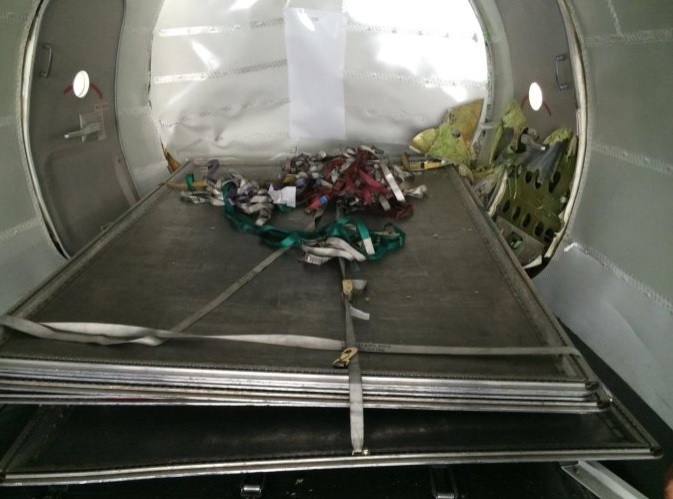Inadequately Secured Pallets Penetrate the Rear Pressure Bulkhead of a Cargo Boeing 737 (Aloha, B737-300, N301KH)
On 16 October 2014 Aloha Air Cargo Boeing 737-330, N301KH flew a cargo to Lanai Airport (LNY), Lanai City, Hawaii. The aircraft was turned around but shortly after rotation on the return flight the aircraft experienced a load shift that caused substantial damage to the aft pressure bulkhead, preventing pressurisation. the aircraft landed safely with no injuries to the three occupants.
The Accident Flight
The US National Transportation Safety Board (NTSB) explain in their safety investigation report issued on 6 April 2020 (nearly 5.5 years later):
Aloha Air Cargo was chartered, by Hawaii Island Air, to fly round trip from [Daniel K Inouye International Airport (HNL), Honolulu, Hawaii] to LNY to deliver lumber for an impeding hurricane. LNY was not a station Aloha Air Cargo normally flew to, nor did they have employees there.
The decision was made to limit the number of Additional Crew Members (ACMs) due to concerns about the return flight’s weight and balance.
With the choice of taking the load planner or the mechanic, Aloha Air Cargo made the decision to take the mechanic, which was against the company loading procedures since the mechanic was not trained on cargo securing nor were there any approved personnel at the destination to assist with loading and securing the empty pallets.
Aloha Air Cargo used various unit load devices (ULDs) in its freighter operation. The LD7 cargo pallet “cookie sheets” consisted of a single skinned pallet with four edge rails, four corner castings and a center sheet section.
Since the load planner would not be making the flight, he discussed with the mechanic on how to load the empty pallets for the return flight, which was to load and lock each empty pallet in their original loaded location.
The aircraft landed at LNY and the lumber was safely offloaded. The investigators explain that:
…while in LNY, Aloha Air Cargo dispatch recommended that all the pallets be placed in position 9 due to concerns about weight and balance. The decision was made to secure the stacked pallets with a cargo strap…
The NTSB note this “was insufficient to keep the pallets from moving”.
The mechanic, first officer (FO), and Island Air employees helped to load the aircraft and verified that the locks were up and locked in all positions. There were a total of 8 empty pallet cookie sheets. Of these sheets 7 were strapped down and secured to the 8th sheet. The 8th sheet was then locked down in position 9 (the aircraft was equipped with 9 cargo positions on the main deck with the ninth position being the most aft and turned lengthwise). This was done per dispatch’s request for center of gravity (CG) consideration…
On rotation the load came loose.
Post event examination revealed that the aft pressure bulkhead had substantial damage, left aft (L2) door panel was damaged, and the right hand forward and aft pop up locking mechanism “claws” were detached/torn from their seat tracks.
The first indication of a problem to the crew was….
…upon reaching 10,000 ft. the altitude alert horn came on so the crew leveled at 10,000 ft. No emergency was declared. The aircraft landed uneventfully. Upon arrival the flight crew notified dispatch of the pressurization issue [and] made a log book entry.
The damage was subsequently detected.
NTSB Probable Cause
NTSB determined this accident was due to:
…the improper loading and securing of the cargo pallets, which shifted on departure, resulting in substantial damage to the aft pressure bulkhead.
Despite not determining a contributory cause, the lack of the required competent loading expertise on site and dispatch’s late, and not fully considered request, for a change to the loading plan are significant
Safety Resources
We have covered this fatal load shift event previously:
The National Transportation Safety Board determines that the probable cause of this accident was National Airlines’ inadequate procedures for restraining special cargo loads, which resulted in the loadmaster’s improper restraint of the cargo, which moved aft and damaged hydraulic systems Nos. 1 and 2 and horizontal stabilizer drive mechanism components, rendering the airplane uncontrollable.
Contributing to the accident was the Federal Aviation Administration’s inadequate oversight of National Airlines’ handling of special cargo loads.
A previous NTSB investigation into the loss of Fine Air Douglas DC-8-61 cargo aircraft N27UA on 7 August 1997 at Miami is also worth examination.
The National Transportation Safety Board determines that the probable cause of the accident, which resulted from the airplane being misloaded to produce a more aft center of gravity and a correspondingly incorrect stabilizer trim setting that precipitated an extreme pitch-up at rotation, was (1) the failure of Fine Air to exercise operational control over the cargo loading process; and (2) the failure of Aeromar to load the airplane as specified by Fine Air.
Contributing to the accident was the failure of the Federal Aviation Administration (FAA) to adequately monitor Fine Air’s operational control responsibilities for cargo loading and the failure of the FAA to ensure that known cargo-related deficiencies were corrected at Fine Air.
Other Aerossurance articles include:
- Misloading Caused Fatal 2013 DHC-3 Accident
- Culture + Non Compliance + Mechanical Failures = DC3 Accident
- Wait to Weight & Balance – Lessons from a Loss of Control
- The Passengers Who Caused a 737 Tail Strike: Ground Handling Lessons
- Low Viz Helicopter Accident, Alaska, also with a loading aspect.
- Alaskan AS350 CFIT With Unrestrained Cargo in Cabin
- UPDATE 25 April 2020: Fatal R44 Loss of Control Accident: Overweight and Out of Balance
Australian Transport Safety Bureau (ATSB) has issued the report report Aircraft loading occurrences July 2003 to June 2010
This is also not the only NTSB report recently issued after a long delay: NTSB Confirms United Airlines Maintenance Error After 12 Years


Recent Comments